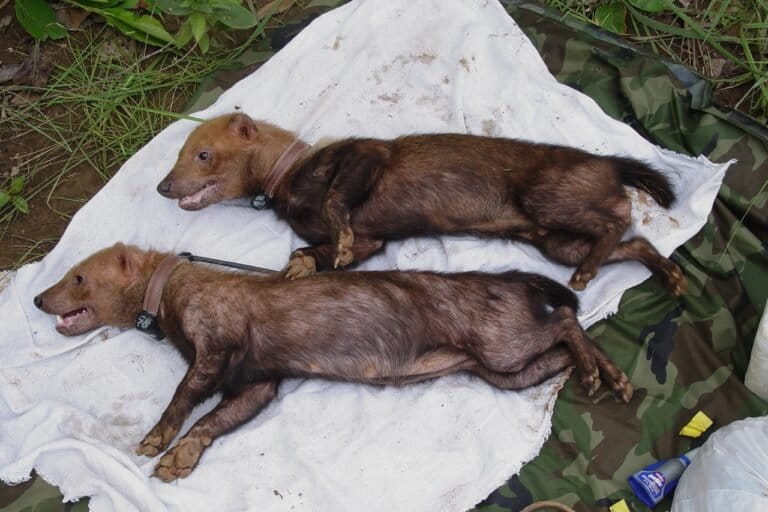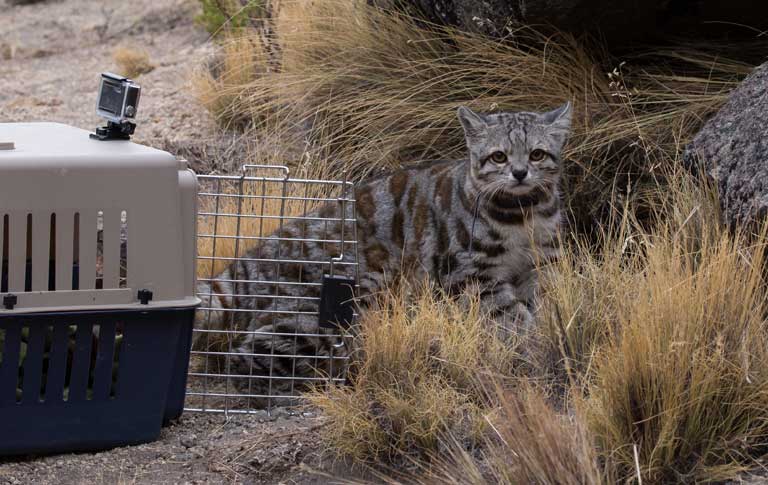- Across Latin America, free-ranging and domestic dogs pose a threat to endangered wildlife, including several small cat species, conservationists say.
- Dogs entering forests or protected areas can disturb wildlife, directly prey upon them, decimate prey populations, and also spread disease.
- Last year, small-cat conservationists from Mexico to Chile united to vaccinate dogs in multiple countries to raise awareness of the problem and mitigate the threat.
- A second phase of this international campaign is planned this May, potentially focused on other threatened species.
On July 18, 2021, a camera trap in the Alto del Nudo region of Colombia captured a pack of free-ranging dogs wandering along a remote forest trail. The next day, an Andean tiger cat (Leopardus tigrinus pardinoides) was spotted on the same route. As innocuous as this may seem, conservationists say it highlights a problem that’s playing out across Latin American countries: free-ranging and domestic dogs are becoming a growing threat to small cats and other wildlife.
In response, conservationists across Latin America are organizing an international campaign to vaccinate and neuter dogs, with help from local people. In 2022, the group, coordinated by The Tiger Cat Conservation Initiative, organized two international events at which they vaccinated more than 1,200 dogs. Another is planned this year with hopes to include more countries and projects.
A tale of dogs and cats
Conservationists report that dogs entering into protected areas can disturb wildlife, directly prey upon them, decimate prey populations, and also spread disease.
Canine distemper virus — a misnomer as it can affect a range of species other than dogs — is one of the primary worries for conservationists. Distemper outbreaks have ravaged populations of carnivores such as African wild dogs and lions in other locations around the world. More recently, sarcoptic mange, also known as canine scabies, has also emerged as a potential threat. Globally, diseases spread by domestic animals are considered an “underrecognized” threat to endangered species by some conservationists.

The dog problem also combines with other threats, such as deforestation or habitat fragmentation, said Karen DeMatteo, a senior lecturer at Washington University in St. Louis and coordinator of the Amazonian Canids Working Group at the IUCN, the global wildlife conservation authority. She described this combination as a “cascade effect.”
“It’s not just the loss of habitat or the loss of prey,” she said. “It’s the fact that this puts them closer to humans, which usually brings them closer to domestic dogs.”
Vaccinating and neutering domestic dogs near protected areas is one step toward minimizing the threat, Tadeu de Oliviera, a professor at Maranhão State University in Brazil, who is coordinating the vaccination campaign, told Mongabay in an interview.
Others, however, advocate for more extreme measures in certain cases. In a paper published last year, researchers including Rocío Contreras-Abarca from the University of Chile, argued that redefining what makes a dog feral should be considered, and that ultimately lethal measures may be necessary to tackle the issue and conserve wildlife.
“Vaccinations will prevent disease transmission, but it won’t stop dogs from attacking and predating on other animals,” Contreras said in an interview. In her view, such measures may be necessary in remote areas far from human settlements or in national parks. “They should complement lethal methods and they should not act on their own.”
She acknowledged it’s a highly controversial topic with legal implications, and one that divides both public and conservationists’ opinions.
“It would be needed but because it’s highly controversial, it’s better to set aside. There is no consensus even among the scientific community,” de Oliveira said. He added that, while such measures may be necessary in specific cases, it’s not a policy that could be generalized. The international campaign, for example, is dependent on local peoples’ support as they bring their dogs to be vaccinated.

“We cannot even touch the subject. In [Mirador State Park in Maranhão], when we started, some people did not want us to vaccinate their dogs because they thought we were going to kill them,” he said. In this park, which has a high density of domestic dogs, vaccinations are entering their third year. “We try to get the community on our side so we can minimize the risk.”
Vaccinations from Mexico to Chile
Planning for the international vaccination campaign is under way and is due to take place in May. Over the course of a day, conservationists aim to vaccinate dogs simultaneously across dozens of sites near protected areas. Conservation projects from Mexico, Bolivia, Costa Rica, Ecuador, Colombia, Brazil, Chile, Argentina and Peru will join the campaign, while others from the Amazonian Canid Working Group could yet join, de Oliveira said.
DeMatteo agreed that these efforts are vital and that they hold benefits for multiple at-risk species, such as the crab-eating fox (Cerdocyon thous) and bush dogs (Speothos venaticus). “All of those will be protected under this international vaccine campaign,” she said.
The program is growing, but with limited capacity, and authorities need to support it, de Oliveira said. “It needs to be continuous; you cannot just do it once … Because the thing is, we are detecting more diseases that we didn’t know about.”
In Chingaza, Colombia, Catalina Sanchez Lalinde, director-general of the NGO ONCA, is working with local authorities to vaccinate dogs against rabies, canine distemper and parvovirus, which, if left untreated, has a very high mortality rate. “I think it’s good that the government and authorities are interested in participating,” she said. “People want to do the work, but they don’t have the resources to do it.”

This is the second year her organization will be taking part in the international campaign, which she said is helping raise awareness of the issue while making an impact.
“I think one of the things we are showing is that no matter if you live in Mexico or Costa Rica, Brazil or Colombia, we are one team and we are all working together to mitigate transmission,” Sanchez said. “It is one way we can help small cats and other species of carnivore too.”
Citations:
van de Bildt, M. W. G., Kuiken, T., Visee, A. M., Lema, S., Fitzjohn, T. R., & Osterhaus, A. D. M.E. (2002). Distemper outbreak and its effect on African wild dog conservation. Emerging Infectious Diseases, 8(2), 212. doi:10.3201/eid0802.010314
Viana, M., Cleaveland, S., Matthiopoulos, J., Halliday, J. O., Packer, C., Craft, M. E., … Lembo, T. (2015). Dynamics of a morbillivirus at the domestic–wildlife interface: Canine distemper virus in domestic dogs and lions. Proceedings of the National Academy of Sciences, 112(5), 1464-1469. doi:10.1073/pnas.1411623112
Escobar, L. E., Carver, S., Cross, P. C., Rossi, L., Almberg, E. S., Yabsley, M. J., … Astorga, F. (2022). Sarcoptic mange: An emerging panzootic in wildlife. Transboundary and Emerging Diseases, 69(3), 927-942. doi:10.1111/tbed.14082
Contreras-Abarca, R., Crespin, S. J., Moreira-Arce, D., & Simonetti, J. A. (2022). Redefining feral dogs in biodiversity conservation. Biological Conservation, 265, 109434. doi:10.1016/j.biocon.2021.109434
de Oliveira, T. G., Lima, B. C., Fox-Rosales, L., Pereira, R. S., Pontes-Araujo, E., & de Sousa, A. L. (2020). A refined population and conservation assessment of the elusive and endangered northern tiger cat (Leopardus tigrinus) in its key worldwide conservation area in Brazil. Global Ecology and Conservation, 22, e00927. doi:10.1016/j.gecco.2020.e00927
de Souza Lima, E., DeMatteo, K. E., Jorge, R. S., Jorge, M. L. S., Dalponte, J. C., Lima, H. S., & Klorfine, S. A. (2012). First telemetry study of bush dogs: Home range, activity and habitat selection. Wildlife Research, 39(6), 512-519. doi:10.1071/WR11176
Banner image: Andean Cat. Photo by Juan Reppucci/courtesy of Andean Cat Alliance
FEEDBACK: Use this form to send a message to the author of this post. If you want to post a public comment, you can do that at the bottom of the page.
